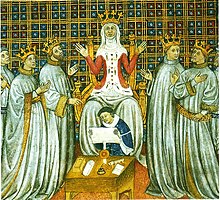Chrodechild

Chrodechild (also Chrodichild , Chrodechilde , Latin Chrodigildis ; the name forms Chlothilde , Clothilde , Klothilde , under which she is received in late medieval and modern literature, are not authentic) (* around 474 in Lyon ; † June 3, 544 in Tours ) was the second wife of Clovis I and through this marriage Queen of the Franks . As a holy Clothilde or Chlothilde she is venerated by the church.
Life
She was born the daughter of Chilperic II and died in the monastery of Saint-Martin de Tours . The earlier partially held view that her mother was Queen Caretene , who died in 506 , is no longer upheld in modern research. In any case, she was a niece of the Burgundian kings Gundobad and Godegisel .
Chrodechild and her sister were brought up by their uncle Godegisel at his court in Geneva . Chrodechild married the Merovingian Frankish king Clovis I between 492 and 494 on the condition that she was allowed to continue to practice her Christian religion. She professed Catholicism and contributed to the decision of Clovis to also adopt this form of Christianity and not the Arianism widespread among other Germanic peoples . Around 501 Gundobad had the Burgundian law recorded, in 506 the Lex Romana Burgundionum followed for the novels.
Their children were all baptized - the two older sons Ingomer and Chlodomer before their father. However, when Ingomer died early and Chlodomer became seriously ill, Clovis blamed his wife's religion. Only when the second son recovered and Clovis begged the Christian God for help in a great battle against the Alemanni and won the battle, did he - and with it his kingdom - convert to Catholic Christianity.
At Christmas in 497, 498 or 499, Clovis was baptized by Bishop Remigius of Reims with 3,000 other francs . Because of her contribution to this decision, Chrodechild was seen by the church as a pioneer for the Catholic faith in Europe.
From her marriage to Clovis she had four sons and a daughter:
- Ingomer, * around 493 or 494, † very young
- Chlodomer , King of Orléans from 511 to 524
- Childebert I , King in Paris from 511 to 558
- Chlothar I , from 511 to 561 king in Soissons , later king of the Franks
- Chlodechild, † 531, buried in the Apostle Church in Paris; she married the Visigoth king Amalrich in 526 or 527
After the death of her son Chlodomer on a campaign against the Burgundians in 524, Chrodechild took over the protection of his three underage sons, their grandsons Theudoald, Gunthar and Chlodoald (Chlodowald) in order to secure their right of inheritance in the realm of the late king. However, this failed because of the resistance of Childebert I and Chlothar I, who wanted to divide up the kingdom of Chlodomer and eliminate the inheritance claims of their underage nephews. As the historian Gregor von Tours reports, Chlothar and Childebert used a ruse to take control of the children and then asked Chrodechild whether the children should be shorn and thus rendered incapable of rule or killed. Chrodechild replied that she would rather see the children dead than unable to rule. Chlothar then killed ten-year-old Theudoald and seven-year-old Gunthar with his own hands; Chlodoald was saved from his uncle under unspecified circumstances and survived by entering the clergy.
After the death of Clovis in 511, Chrodechild founded monasteries and donated churches. Like her husband and daughter, she was buried in the Church of the Apostles in Paris, which later became the Church of Sainte-Geneviève .
As a holy Clothilde, she is venerated as the patroness of women and notaries . She is often depicted with a church model and a book, Giving to the Poor. Their festival is June 3rd. Sébastien Mamerot names in his Histoire des neuf preux et des neuf preuses (1460–1461) as one of the nine good heroines . The basilicas Ste-Clotilde (Paris) and Ste-Clotilde (Reims) were named after her.
literature
- Hans Hubert Anton : Chrodechilde . In: Reallexikon der Germanischen Altertumskunde . Volume 4, 1981, pp. 604-605.
- Justin Favrod / GG: Chrodechilde. In: Historical Lexicon of Switzerland . 2005
Web links
- Article Clothilde , in: Stadler's Complete Lexicon of Saints
- Article St. Clotilda , in: The Catholic Encyclopedia
Remarks
- ↑ See Martina Hartmann : The Queen in the Early Middle Ages . Kohlhammer, Stuttgart 2009, ISBN 978-3-17-018473-2 , p. 11.
- ↑ See Hans-Werner Goetz : Europe in the early Middle Ages 500-1050 . Stuttgart 2003, p. 42.
| personal data | |
|---|---|
| SURNAME | Chrodechild |
| ALTERNATIVE NAMES | Chrodechilde, Chrodichild |
| BRIEF DESCRIPTION | Wife of Clovis I. |
| DATE OF BIRTH | at 474 |
| PLACE OF BIRTH | Lyon |
| DATE OF DEATH | June 3, 544 |
| Place of death | Tours |